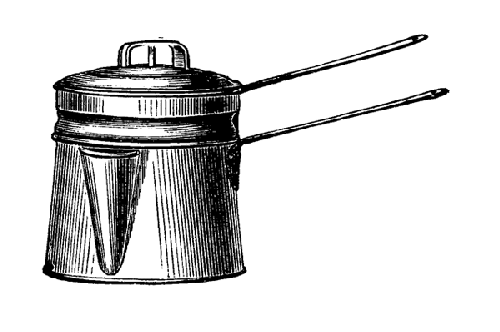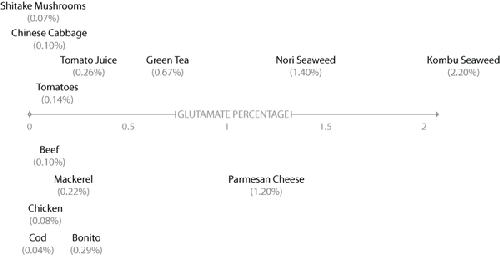3. Sour
Sour tastes are caused by acids in foods. The sensation of sourness is detected by
part of the taste bud (ion channels) interacting with the hydrogen ions in the acids.
Quite literally, your sour taste buds are a primitive chemical pH tester. In cooking,
lemon juice and vinegar are commonly used to make dishes more sour, sometimes for effect
but more often to bring balance. When cooking, taste the food and think about the balance
of both saltiness and sourness, adding an ingredient such as vinegar to “brighten up” the
flavors.
Note:
In Latin American and Asian cuisines, tamarind paste is often used to adjust the
sourness of a dish.
From an evolutionary perspective, we appear to have evolved to taste sourness as one
method of determining spoilage, because a number of acids are produced by bacteria during
the breakdown of food. This isn’t to say that sourness in food is always due to bacterial
breakdown or that the fermentation caused by bacterial breakdown necessarily results in
bad food. Lemon juice is sour due to citric acid, and yogurt (pH of 3.8–4.2) acquires a
sour taste because of the lactic acid created by the bacteria breaking down the lactose in
the milk (pH of 6.0–6.8).
To get a better understanding of how bacteria make the taste of a food more sour, try
making your own yogurt using the recipe in Yogurt, tasting the liquid
before and after fermentation.
4. Sweet
We’re hardwired to like sweet foods—no surprise here. Sweet tastes signal quickly
digestible calories (and thus fast energy), which would have been more important in the
days when picking up the groceries also involved picking up a spear.
Our desire for sweetness changes over our lifespan. Researchers have found that our
preference for sweetness decreases as we mature. A child’s preference for sweet things is
biologically related to the physical process of bone growth. (Quick, kids, run and tell
your parents that your sweet tooth is
because of biology!) And the infamous sweet tooth isn’t unique to
American kids either; this finding holds up in other cultures.
Sugar is good at simultaneously promoting other flavors while masking sour and bitter
tastes. Take ginger, which has a strong, pungent, and slightly sour taste. With a bit of
sugar, it becomes enjoyable on its own; sugared and dipped in chocolate, it becomes
irresistible. Try making a simple ginger-flavored syrup (recipe at right).
In a pot, bring to a boil and then simmer on low heat: 2 cups (470g) water ½ cup (100g) sugar 6 oz (65g) ginger (raw), finely chopped or
minced
Simmer for 30 minutes, let cool, and then strain the mix into a bottle or container,
discarding the strained-out ginger pieces. Besides adding it to club soda for a simple ginger soda, try using this syrup on top
of pancakes or waffles or in mixed drinks (ginger mojitos!). You can also add a vanilla
bean, split lengthwise, to the mix while boiling to impart a richer flavor. And if the
idea of chocolate-covered candied ginger is still bouncing around your head. |
5. Umami (a.k.a. Savory)
Umami (a Japanese word that roughly translates to “savory”) generates a meaty,
broth-like, lip-smacking sensation typically triggered by some amino acids and nucleotides
(glutamate is the poster child; inosinate, guanylate, and aspartate are also not
uncommon). Glutamate is naturally present in a number of foods, especially mushrooms. To
an average American palate, umami is more subtle than the four primary tastes. It tends to
amplify our other senses of taste. For example, in dishes with salt, umami “brings out”
the salty taste, meaning that you can cut the amount of salt in a dish by adding
umami-tasting ingredients.
If you’re unable to imagine the taste of umami, make a simple broth by rehydrating a
tablespoon of dried shiitake mushrooms in 1 cup (240g) of boiling water. Let the mushrooms
steep for at least 15 minutes, and then remove them and save them for something else
(mmm, stir-fry). Taste the liquid; it will have a high glutamate
content dissolved out from the mushrooms. (If this is too much work for you, I suppose you
could just snag a container of MSG from your local Asian grocery store and dissolve a
small amount in a glass of water.)
Why we’ve evolved to have taste sensors for umami isn’t fully clear. Sweetness and
saltiness are both associated with positive attributes of food (quick energy in the case
of sweets and an element essential for regulating blood pressure in the case of
saltiness), while sourness and bitterness indicate potential danger. Perhaps umami is a
more subtle indicator of protein content, as a way of ensuring we ingest enough amino
acids to maintain muscle function. Regardless, umami is worth understanding for the
hedonistic value alone. MSG (monosodium glutamate) is to umami what sugar is to sweetness:
as a chemical, it’s relatively odorless (still full of taste!), but it triggers the umami
receptors on the tongue. MSG has gotten a bit of a bad rap in the United States, but so
have salt and sugar at various times.
In a pan (or, preferably, a double-boiler),
gently heat: 1 cup (240ml) milk (any type other than
lactose-free)
Bring the milk up to 200°F / 93.3°C and hold at that temperature for 10 minutes
using a candy or IR thermometer. Do not boil, because that will affect the yogurt’s
flavor. After 10 minutes at temperature, transfer the milk to an open thermos, and wait
until it cools to 115°F / 46°C. Add and stir to combine: 1 tablespoon (14g) yogurt
Screw the lid onto the thermos and incubate for four hours. Transfer the liquid to a
storage container and put it in the fridge immediately. Notes The small addition of yogurt acts as a starter
because it contains the proper types of bacteria for “good” yogurt. Make
sure you use yogurt that states it has “active cultures.” 
This recipe sterilizes the milk (pasteurized milk can still have a low
level of bacteria) and keeps the incubation period to four hours to reduce the
chance of growth of foodborne illness-related bacteria. Longer incubation times
lead to a stronger, more developed flavor. As with anything you eat, keep in mind
that if it tastes bad, smells off, or looks up at you and cracks a joke, you
probably shouldn’t eat it. (The inverse is, of course, not true: just because
something smells fine doesn’t mean it’s necessarily safe.) Try adding honey to the hot milk to take the sour edge off the
finished product (sweet helps mask sour). For “Greek-style” thick yogurt, place
the yogurt in a strainer over a bowl and let it drip-strain overnight in the
fridge. 
|
There
are plenty of natural sources of glutamate. Many traditional Japanese dishes call for
dashi, a stock made from ingredients high in natural glutamate such
as kombu seaweed (2.2% glutamate by weight). Making dashi is super easy: in a pot, place 3
cups (700g) cold water and a 6″ / 15 cm strip of kombu (dried kelp), and let rest for 10
minutes. Bring to a boil slowly on low heat. Remove the kombu just before the water begins
to boil and add 10g of bonito flakes (flakes of dried and smoked bonito fish). Bring to a
boil, remove from heat, and strain out the bonito flakes. This liquid is dashi. To make
miso soup, add miso paste, diced tofu, and (optionally) sliced green onions, nori, or
wakame (an edible seaweed).
Glutamate occurs naturally in many other foods—for example, beef (0.1%) and cabbage
(0.1%). And if you’re like most geeks and pizza makes your mouth water, it might be
because of the glutamate in the ingredients: Parmesan cheese (1.2%), tomatoes (0.14%), and
mushrooms (0.07%).
Glutamate content of common ingredients.
